TREES Page four
How I go about painting trees and forests on Backcloths; Flats and Wings.
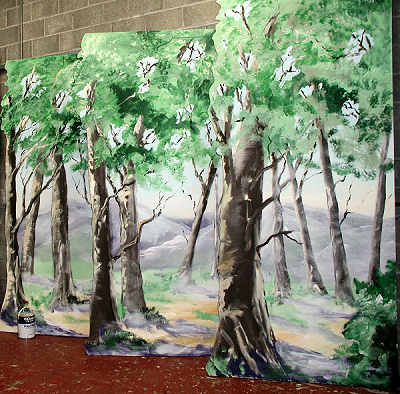
It's fun to make the trees on the upstage wings smaller than those downstage, adding apparent depth to your stage.
But beware because cast arriving upstage might look like giants.
Likewise, when actors arrive onstage, in theory the audience should see them through the trees of the wings. But they don't and "belief is happily suspended".
Cowboys don't usually sing "Oh what a beautiful morning" either. - unless you know different!
Three wings for Oklahoma! taken in workshop
5 ltr paint tin for scale
Mind you if the wings are wide enough it is fun to cut out a void in the downstage wing so the actor can be seen though the trees as he arrives on stage.
However the cast must be aware of this hole as they will seen standing in the wings.
I have, on occasions, cut holes in the foliage of a downstage wing so the foliage of the upstage wing can be seen through them. This is not so drastic and dangerous as cutting a hole amongst the trunks. (Unless you have fifteen feet high actors! )

Another fun trick is to force the perspective on, say, a fence which is on all the wings.
Have the fence woodwork getting smaller and thinner on the up stage wings.
But again watch for those "giant" actors.
PERSPECTIVE IN WINGS
Now here it gets interesting!
Let's assume our wings depict a stand of trees with the sea horizon peeping though from behind them.
The horizon on, say, the downstage pair of wings (Audience left and right) works without a problem. But where do we place the sea horizon on the upstage wings? And where do we place the horizon on the backcloth?
OK so in this experiment we will put the horizon on all the wings at, say, four feet above the stage floor. Now much depends upon the layout of the audience seats. But whatever the layout there's only one row of seats where this horizon construction will "work". If they are all on the flat; if the seats are raked; if there's a balcony. All these scenarios mean the audience sees a different horizon depending upon where they are sitting.
I won't dwell on this problem too much (If you are keen you could work out the geometry involved for your own theatre. - but it is not worth the effort)
Me? I usually fudge the problem.
See my distant mountains in the top Oklahoma! wings photo.
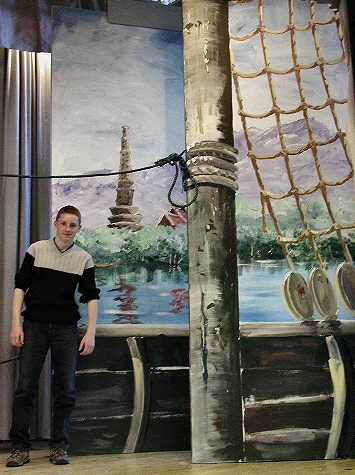
But the edge of the river bank was a different matter and that only 'worked' for one row of seats in the auditorium. Not that anyone appeared to notice. We all know it aint real.
CHECKERED
if it is a dark background, contrive to have a white trunk or branch and vice versa. See photo below which is a bit over the top but explains what I mean.
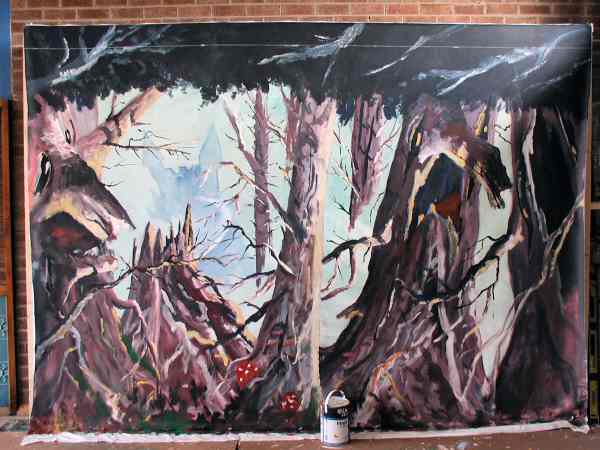
Wizard of Oz spooky forest. Paint tin for scale
SILHOUETTES and unusual outlines.
Give interest. I often use a dark silhouette to "frame" a painting and give depth.
See tree on left in photo below.
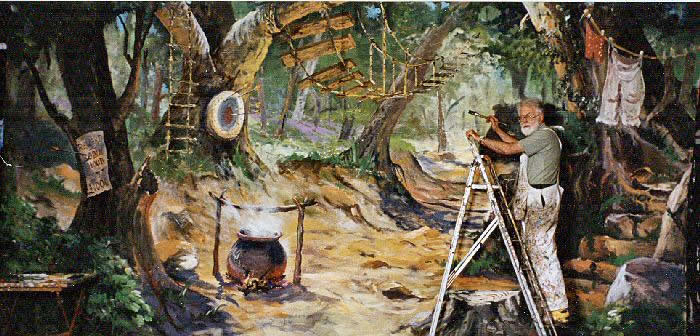
GROUND ROW
If convenient. It's nice to be able to put in a painted ground row in front of a forest backcloth.. Perhaps a bush or a large fallen tree trunk.
SHADOWS
There are two sorts of shadows:-
A/. The "Dark Side" of an element
B/. The shadow "Cast" by that element.
The Dark Side is a great help in describing the roundness of a trunk or bough.
Whereas the shadow Cast by an element is useful in showing the texture and shape of the ground on which it is falling. The most important of these are the shadows cast by the tree trunks on the ground which tells the audience which direction the sun is and also shows the texture of the ground on which the shadow is falling. A shadow falling on a boulder gives you a great excuse to paint it over the boulder surface.
And of course trunks and branches also cast shadows on other trunks and branches in your scene.
When painting shadows on trunks/branches paint them to follow the contours, This helps to show the 'roundness'.
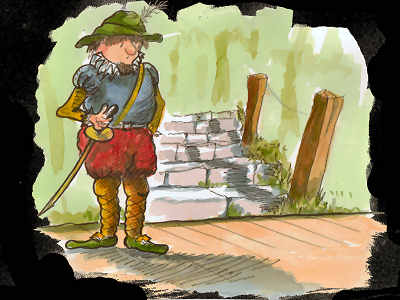
Now here's a funny thing.
If you paint shadows on a backcloth or wing but the stage lights make the actors' shadows go in a different direction, the audience doesn't notice.
Note in this sketch how I have the foreground post life sized to scale with the actor.